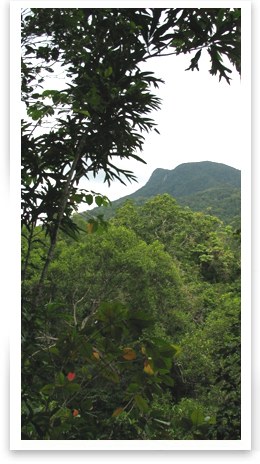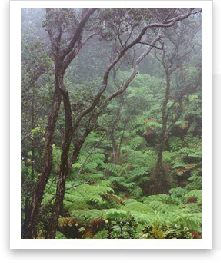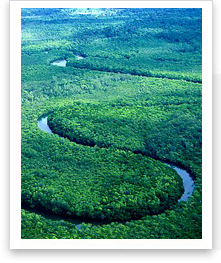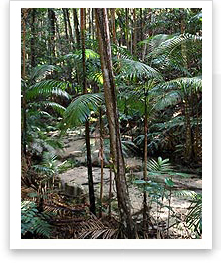Australian rainforests - an overview
Australian rainforests are unique in that their distribution covers a wide climatic range, and they are often subjected to prolonged periods of low water availability, unlike much of the rainforests of the equatorial tropics. No Australian climatic zone supports true tropical evergreen rainforest as found in the equatorial regions - there is always a dry season, the length of which is often critical in determining the floristic composition and the degree of deciduousness (Hutley et al. 1997).
The rainforests of Australia occur in an arc following the coastal 800 mm rainfall isohyet, stretching from the dry monsoonal regions of northern Australia to the cool temperate forests of Tasmania and Victoria.
![]()
Activity 3.5
The fragmented distribution of Australian rainforests
- Go to a map of Australian vegetation
Rainforests and vine forests are marked in red (Major vegetation type 1, MV1). You will see what a small fraction of the continent they cover - compare to the area occupied by Eucalypt open forest and woodlands. It is barely possible to see any rainforests mapped for the ‘Top End’ of north Australia at the scale of this map. In fact there are nearly 15, 000 patches (Russell-Smith 1991) of monsoon vine forest patches scattered across this region.
The discontinuous distribution, with much structural and floristic diversity, suggests a complex of factors (environmental, biotic and historical) determining the occurrence of a particular forest type at a given site. Australian rainforest classification are essentially physiognomic (structural) and Webb et al. (1984) developed a physiognomic classification for Australian rainforest based on the following features of the vegetation and climate;
- seasonality (evergreen, semi-evergreen, semi-deciduous, deciduous)
- leaf morphology and size (mesophyll, notophyll, microphyll, nanophyll)
- life form (emergents, vines, moss, ferns, fan palms, palms)
height (forest, woodland, thicket)
Using these features, 3 primary divisions were delineated; the vine forests (tropical and subtropical), fern forests/vine-fern forests (submontane and warm temperate) and mossy forests/fern-mossy forests (montane and temperate). These general groupings were divided further, resulting in 20 structural types being recognised. This and the later floristic classification reflected environmental factors controlling rainforest distribution in Australian which include;
Rainfall and its seasonality
A feature of the Australian climate is it’s aridity and variability, which has resulted in the dominance of sclerophyllous vegetation. Although rainforest can generally be considered a mesic environment (Whitmore 1984), almost all Australian rainforest vegetation experiences severe water deficits at some stage of their life cycle. Dry seasons of northern Australian climatic regions supporting rainforest can last up to 6 months of the year. Measurements of leaf water potential of upper crown leaves of tropical montane Australian rainforest trees provide values characteristic of plants suffering significant water deficits. These trees may be in the order of hundreds of years old and thus have experienced numerous periods of water stress, yet have survived these periods and have been able to complete their life cycle. The widespread occurrence of CAM photosynthetic pathways in vascular epiphytes which inhabit upper regions of rainforest crowns supports the notion that these crowns experience arid environments.
We can therefore suggest that Australian rainforest are characterised by species that are conserving of water, which can exert considerable stomatal control over water loss. Mature phase successional species tolerated water stress, whereas pioneer species avoided stress through changes in morphology and physiology. These physiological characteristics (stomatal physiology, light use efficiency, rates of assimilation and respiration) enabled the maintenance of favourable water balances in differing successional niche types, features that would be critical to survival of rainforest species in seasonally dry environments.
Fire frequency and intensity
A major difference between Australian and rainforest of the rest of the tropical world is the ecological importance of fire and its impact on rainforest dynamics (Bowman 2000). Rainforest in Australia, with the exception of large blocks or rainforest massifs of the coastal wet-tropics of north-eastern Queensland, occur in discrete patches surrounded by the flammable Eucalypt open forests, woodlands and savannas. As such, fire is a significant factor controlling rainforest boundaries, as rainforest species are typically less well adapted to fire than the fire-prone, but-fire resistant Eucalypt forests (Bowman 2000). In fire prone areas, rainforest occurrence is restricted to fire-proof gullies. During a prolonged fire free periods, rainforest boundaries will expand as rainforest species have high growth rates and are capable of tolerating dry periods and droughts typical of the Australian tropics. However, repeated fire results in high levels of seedling mortality (Fensham et al. 2003) and rainforests contract to moist, fire free gullies or riparian areas. In the absence of fire, rainforest expands into the surrounding Eucalypt forest, with the rate of this expansion rapid on sites of rich basalt soils (Russell-Smith et al. 2004a, b).
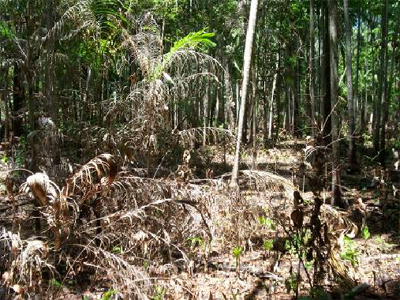
Figure 5 Fire penetration into the understorey of a monsoon vine forest patch, Whitewood Road Jungle, Howard Springs, NT. This forest patch is near urban development and is surrounded by savanna vegetation and is subjected to fire events every 3 to 5 years. (Photo L. Hutley).
Such fire-determined rainforest distribution is most strikingly evident in the monsoon vine forests of the north-western Australia. Repeated fire can have a devastating impact the recruitment of rainforest species (Figure 5). This vine forest near Darwin is subjected to frequent fire, which can penetrate up to 100 m into the rainforest patch, as is the case in this photograph and this fire event has killed all understorey vegetation, with limited re-sprouting evident. Fire intensity was highest in canopy gaps, such the one shown, where increased radiation and higher soil temperatures had reduced fuel (litter) moisture content, thus increasing the flammability. Damage or death to individuals within gaps would slow the rate of gap colonisation.
Altitudinal and latitudinal effects on temperature
Outside the high rainfall lowlands of the wet tropics of Queensland, most Australian rainforest occurs in the mountainous terrain. As such altitude and its influence on temperature influences the distribution of rainforest species. Nix (1981) defined three species types based purely on temperature requirements for optimum growth. Megatherms were species requiring mean daily maximum temperatures of 28°C and minimums of 10°C and were found in forests of Papua New Guinea and Cape York. Mesotherms had optimum temperatures in the range of 18°C to 22°C with a minimum of 5°C and were well represented in the rainforest of North Queensland and some areas of Southern Queensland and New South Wales. The third group, the microtherms had optimums in the range of 10-12°C, with a minimum of 0°C, and represented species of the cool temperate forests occurring on high mountain peaks from Papua New Guinea southward to the upland Nothofagus forests of Southern Queensland and New South Wales.
Topographic variation (slope, aspect, exposure, moisture availability) Topography plays a role in determining exposure and microclimate and may be particularly significant at marginal inland or upland sites. In eastern Australia, southerly and easterly aspects receive lower radiation loads, resulting in reduced water-loss and are fire protected, thus permitting the survival of rainforest species. These aspects may also provide shelter from desiccating and cold westerly winds, a factor which becomes significant at high altitudes. At upland sites with rugged relief, environmental gradients may be steep in terms of radiation and moisture availability. This results in a dynamic vegetation pattern and maybe responsible for the very patchy distribution of rainforest, which is often surrounded by sclerophyllous vegetation on more exposed situations.
Coastal massifs such as the Great Dividing Range are a significant geographical feature. The uplifting of air masses creates orographic rainfall, low cloud and fog, resulting in cool, mesic microclimates. Coastal massifs located inland, such as the Great Dividing Range in southern Queensland, have an ability to entrap and deflect moist air which has a significant local influence on rainfall. Such mountainous sites support rainforest, but in regions where climate may be unfavourable for this vegetation type. However during dry periods, these sites become marginal for a rainforest community and they could become vulnerable to severe water shortages. As rainforest distribution is influenced by moisture availability and temperature, they may be particularly sensitive to climate change induced changes to patterns of precipitation and temperature.
Soil nutritional status
Edaphic (soil) factors (moisture availability, aeration, drainage, depth and nutrient availability) are also significant in influencing rainforest type and frequently determine boundaries with sclerophyll vegetation within a localised climatic zone. Australian rainforest soils are often deep, well drained and permeable and derived from basaltic parent material (Webb and Tracey 1981), which contain high levels of phosphorus and calcium, nutrients critical to rainforest species. The fertility of Australian soils supporting rainforest tends to be variable and can be broadly classified into 3 groups; eutrophic (high fertility), mesotrophic (moderate fertility) and oligotrophic (low fertility). Eutrophic soils of the tropical and sub-tropical regions support the most complex rainforest types, grading to oligotrophic sites, supporting simpler forest interspersed with sclerophyllous vegetation subject to fire (Webb and Tracey 1981). Eutrophic soils are commonly derived from basaltic parent material and typically have a high clay content and high available phosphorous, which can be important in determining forest type.
All of these factors interact to produce a mosaic of rainforest types, Eucalypt dominated forests, open-forests, woodlands and savannas. Figure 6 provides an example of this mosaic, with rainforest ecosystems surrounded by naturally occurring grassy ‘balds’ and Eucalypt forest sand woodlands.
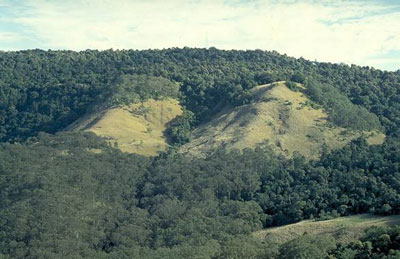
Figure 6 A rainforest – Eucalypt open forest –
grassland mosaic on top slopes of the cool sub-tropical rainforest
massif of the Bunya Mountains, Queensland. Note the sharp boundaries
between ecosystem types, with boundaries controlled by a variety of
factors moisture availability determined by aspect, slope, soil type
plus fire and fire history.
(Image used with permission and courtesy of the Len Webb Ecological
Images Collection, Griffith University.
![]()
Activity 3.6
Regeneration of monsoon vine forest patches of north Australia
Russel-Smith and Setterfield (2006) investigated the regeneration syndromes of dominant woody species of tropical savannas and monsoon rain forests. Can rainforest species survive the wet-dry tropical conditions, with the extended dry season? How well do rainforest species survive fire events, how is their regeneration effected?
Read this paper for a good overview of the ecology and biogeography of monsoon vine patches of north Australia and contrasting regeneration strategies of the rainforest and savanna species in this highly season, fire prone region of Australia.
Describe the differences between the regeneration syndromes of dominant regional monsoon rain forest and savanna taxa.
![]()
Rainforest seed rain occurred mainly during the wet season, with immediate germination and sapling development occurring. Savanna species tend to flower in the dry season and shed seed during the late dry season. Rainforest regeneration was via seed germination, although seedlings suffered high mortality in the dry season and were especially vulnerable to fire. Regeneration of savanna species was via clonal or asexual reproduction and were able to survive the dry and repeated fire vents. The development of lignotubers was evident with the savanna saplings, which was not apparent in rainforest species.
Next topic - Threats to rainforest ecosystems
Topics in this module
